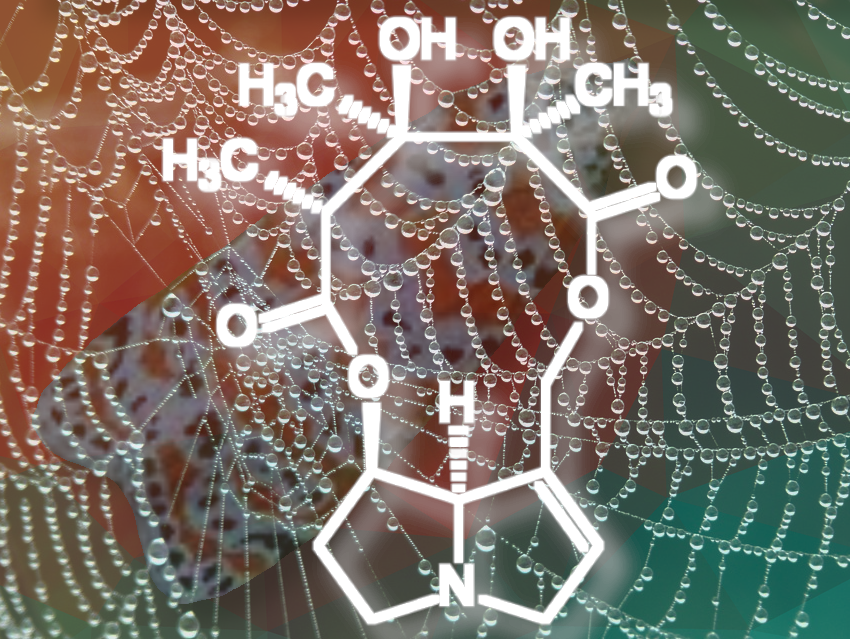Moths fear spiders for good reason—they are a spider’s favorite food, after all. Once trapped in a spiderweb, they try to escape by frantically beating their wings. However, in this situation, little ornate bella moths (Utetheisa ornatrix) remain totally calm. The spider rushes in, briefly feels its prey, and immediately cuts a hole in its web for the ornate bella moth. The moth falls out and before it hits the ground, spreads its wings and flutters away. It was certain of this outcome from the start. Its secret lies in eating the right diet from the moment it hatches, rigorous sex, and a good helping of chemistry.
5 Sex and a Good Helping of Chemistry
The chemical story of the ornate bella moth is not yet at an end. We are coming to the story’s climax: it is time to celbrate the wedding! Lovelorn males beguile their love interest with an unusual trick. As they fly around, they extend two hair pencils from on their abdomen, touching the female for barely a third of a second. This is long enough for the female to gauge the quality of a potential lover. If she likes him, she lifts her wing, and the nine-hour copulation begins.
5.1 How Does the Male Convince the Female of His Skill at Lovemaking in Just Fractions of a Second?
Chemically, of course! His hair pencils contain a decomposition product of monocrotaline, hydroxydanaidal (3) (see Fig. 6). In fact, the male moths break about 30 % of their monocrotaline down into hydroxydanaidal (3). From a biochemical point of view, this is no big deal, because they only have to split two ester groups, dehydrate the pyrrolizidine ring system, and oxidize a primary alcohol to an aldehyde. A healthy pinch of 3 melts the female’s heart, but there is some cold calculation behind it.
 |
|
Figure 6. Hydroxydanaidal (3). |
The intensity of the hydroxydanaidal scent is proportional to the monocrotaline content of the male body. In other words: A healthy pinch of hydroxydanaidal allows the male to signal that he is full of monocrotaline [10,11]! The proof: Males raised in a monocrotaline-free environment have no luck with the ladies.
5.2 Why Is the Female Interested in the Monocrotaline Content of the Male?
When copulating, the male transfers a large sperm package (spermatophore) that accounts for 10 % of its body mass. Extrapolated for a human, that would be about 7 kg!
The sperm package has three functions: it contains sperm to fertilize the eggs, nutrients, and a good helping of monocrotaline. This is a very useful wedding present, because the monocrotaline is partially transferred to the eggs, which are then protected from predators (e.g., ants) [12].
In addition to the eggs, the female herself also benefits. (–)-Females raised without monocrotaline become inedible to spiders within minutes of copulation with a monocrotaline-containing (+)-male [13]. This chemical wedding present reveals itself to be life-long life insurance for the female.
A female will copulate with up to 20 males for nine hours each. With a lifespan of only 30 days, this keeps the female fully occupied. Because each act of copulation results in the transfer of more monocrotaline to protect her eggs, this extravagant sex life serves the survival of her species.
After the last copulation, the female decides who will father of the next generation. For her many wedding nights, the female selects her partners by their hydroxydanaidal scent. However, she cannot guarantee that she did not get fooled by impostors who have a strong odor but do not actually have a lot to offer. The female can now correct this error.
With her labyrinthine reproductive system, she measures the size of each sperm packet she received [14] and selects the largest. Phonies have no chance to become fathers but do contribute to the survival of their species because the eggs benefit from their monocrotaline contributions. The female deposits the chemically protected eggs on Crotolaria mucornata plants, beginning a new life cycle (see Part 1).
6 Summary
The little woolly bear Utetheisa ornatrix is a chemical survival artist. It lives on a plant that other insects and plant eaters avoid. The bitter substance in the plant, cytotoxic monocrotaline, suits it perfectly: By storing this alkaloid, the ornate bella moth protects itself from predators in all stages of life (e.g., caterpillar, pupa, and moth).
Moreover, the male uses the toxin to synthesize a sexual lure to beguile the females. When mating, the male transfers a sperm package stuffed full of nutrients and protective monocrotaline for the unhatched eggs. The mother also provides for her offspring, using the numerous chemical gifts she receives over many copulations to protect them.
From a chemical point of view, Utetheisa ornatrix moths are nurturing parents because they make sure to provide the right food for their little ones, have rigorous sex, and serve up a good helping of chemistry.
Acknowledgments
I thank Professor T. Eisner, Cornell University for his help. Professor Wachmann, FU Berlin, Germany, significantly improved my article with his expertise in zoology.
References
[10] D. E. Dussourd, C. A. Harvis, J. Meinwald, T. Eisner, Pheromonal advertisement of a nuptial gift by a male moth (Utetheisa ornatrix), Proc. Natl. Acad. Sci. USA 1991, 88, 9224–9227. https://doi.org/10.1073/pnas.88.20.9224
[11] T. Eisner, J. Meinwald, The chemistry of sexual selection, Proc. Natl. Acad. Sci. USA 1995, 92, 50–55. https://doi.org/10.1073/pnas.92.1.50
[12] T. Eisner, For Love of Insects, Harvard University Press, Cambridge, MA, USA, 2003. ISBN: 9780674018273
[13] A. González, C. Rossini, M. Eisner, T. Eisner, Sexually transmitted chemical defense in a moth (Utetheisa ornatrix), Proc. Natl. Acad. Sci. USA 1999, 96, 5570–5574. https://doi.org/10.1073/pnas.96.10.5570
[14] C. W. LaMunyon, T. Eisner, Spermatophore size as determinant of paternity in an arctiid moth (Utetheisa ornatrix), Proc. Natl. Acad. Sci. USA 1994, 91, 7081–7084. https://doi.org/10.1073/pnas.91.15.7081
The article has been published in German as:
- Die Chemie eines kleinen Spinners,
Klaus Roth,
Chem. unserer Zeit 2005, 39, 72–76.
https://doi.org/10.1002/ciuz.200590010
and was translated by Caroll Pohl-Ferry.
The Amazing Chemical Survival Strategy of a Moth – Part 1
The secret: the right diet from the start, rigorous sex, and a good helping of chemistry
See similar articles by Klaus Roth published on ChemistryViews.org




